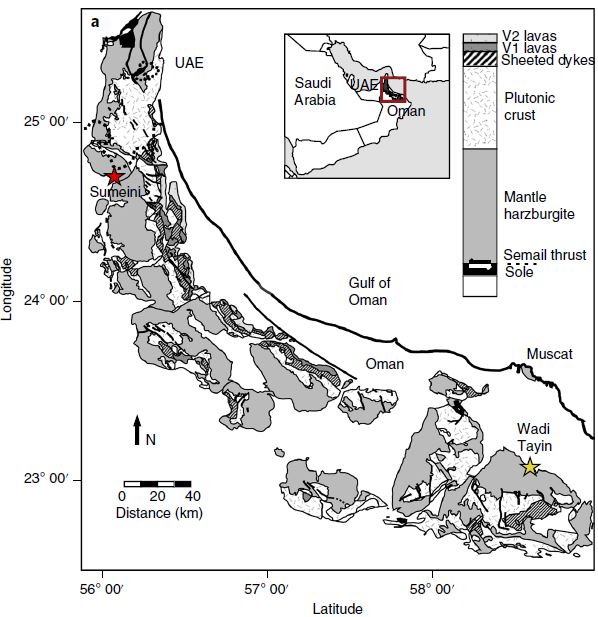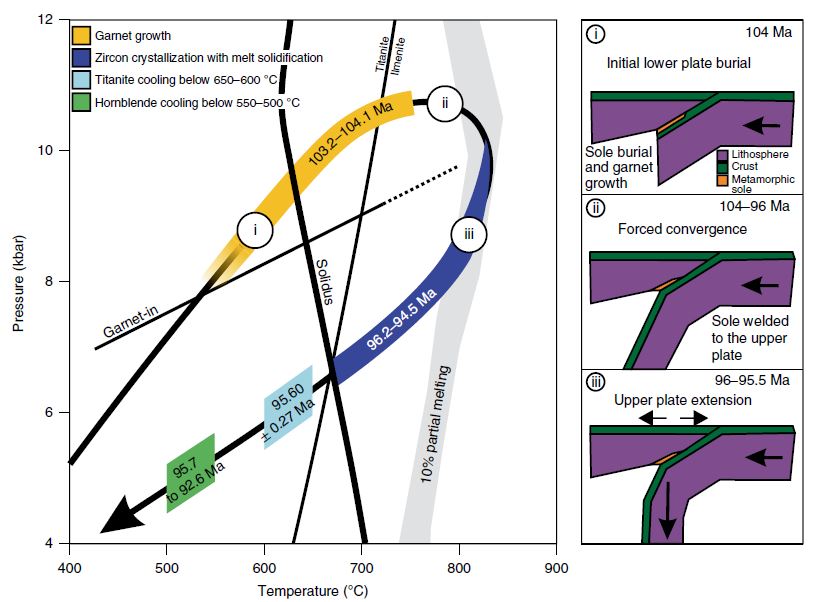【国际动态】Nature Geoscience: Forced subduction initiation recorded in the sole and crust of the Semail Ophiolite of Oman
Subduction zones are unique to Earth and fundamental in its evolution, yet we still know little about the causes and mechanisms of their initiation. Numerical models show that far-field forcing may cause subduction initiation at weak pre-existing structures, while inferences from modern subduction zones suggest initiation through spontaneous lithospheric gravitational collapse. For both endmembers, the timing of subduction inception corresponds with initial lower plate burial, whereas coeval or delayed extension in the upper plate are diagnostic of spontaneous or forced subduction initiation, respectively. In modern systems, the earliest extension-related upper plate rocks are found in forearcs, but lower plate rocks that recorded initial burial have been subducted and are inaccessible. Guilmette et al. (2018) investigate a fossil system, the archetypal Semail Ophiolite of Oman, which exposes both lower and upper plate relics of incipient subduction stages. They show with Lu–Hf and U–Pb geochronology of the lower and upper plate material that initial burial of the lower plate occurred before 104 million years ago, predating upper plate extension and the formation of Semail oceanic crust by at least 8 Myr. Such a time lag reveals far-field forced subduction initiation and provides unequivocal, direct evidence for a subduction initiation mechanism in the geological record.
Two main conceptual end-member mechanisms considered are ‘induced’ and ‘spontaneous’ subduction initiation (Fig. 1). Induced subduction initiation (ISI) requires a period of forced convergence, presumably accommodated at a pre-existing favourably orientated weak structure, until subduction eventually becomes self-sustained. Alternatively, gravitational instability across oceanic transform faults or passive continental margins has been proposed to trigger lithospheric collapse and spontaneous subduction initiation (SSI) without net plate convergence. A fundamental criterion that would discern between ISI and SSI is the time lag between initial lower plate burial and the ensuing upper plate extension (Fig. 1). During SSI, the area consumed by subduction must simultaneously be balanced by area gained through upper plate extension. In contrast, upper plate extension following ISI must be generated by the growing slab after a period of forced underthrusting, resulting in a time lag of several millions of years. Constraining the magnitude of this time lag requires specific geochronological methods applied to a rock record of both the formation of the incipient subduction thrust and the onset of upper plate extension.

Fig. 1 | Conceptual lithospheric sections representing SSI versus ISI.
The time lag between initial lower plate burial and incipient upper plate
extension is diagnostic of the subduction initiation mode.
The Semail Ophiolite. Many SSZ ophiolites rest on thin (< 500 m) sheets of metamorphosed oceanic crust termed metamorphic soles. These metamorphic soles derive from the uppermost crust of the subducting lower plate that was preserved from further subduction by ‘welding’ to the mantle section of the upper plate during subduction zone infancy.The Semail Ophiolite (Fig. 2) exposes over 20,000 km2 of oceanic crust and upper mantle rocks underlain by a discontinuous thin sheet of metamorphic sole.

Fig. 2 | Geological maps, sample locations and field relationships. a, Geological map of Oman.
Garnet growth (Fig. 3), revealed by the Lu-Hf isochrons, in the metamorphic sole at 104 Ma and the onset of SSZ crustal accretion by 96 Ma constrains a > 8 Myr time lag between initial lower plate burial and the onset of upper plate extension, implying a > 8 Myr period of forced convergence before upper plate extension. This time lag constitutes the first direct evidence from the geological record for ISI. The far-field causes driving the forced convergence should be sought considering the pre-104 Ma plate configuration and evolution, not the 96 Ma syn-upper plate extension configuration.
The new results imply that SSZ ophiolite formation is not unequivocal evidence for SSI, as is often assumed for Semail and other large and well-preserved ophiolites. In fact, SSZ ophiolite formation indicates the onset of upper plate extension, which does not date subduction initiation in ISI. Both the magnitude of the time lag between initial lower plate burial and incipient upper plate extension, and the age of the onset of convergence convey critical, previously unavailable information on subduction initiation. The magnitude of the time lag should reflect the balance between forces driving and resisting upper plate extension, depending on the nature, geometry and kinematics of the intervening plates, as indicated by numerical models. The plate configuration and kinematics in which new subduction zones were initiated in the geological past might have significantly predated the earliest expression of upper plate spreading represented by ophiolitic or modern forearc crust. Such new insights into subduction initiation processes open new avenues for reconceptualization of the initiation and processes of global plate tectonics.

Fig. 3 | Pressure–temperature–time evolution of the Semail metamorphic sole.
诱发俯冲起始的首例地质证据——对蛇绿岩研究的启示
俯冲起始是指俯冲带发育为成熟俯冲体系之前的短暂过程,它是洋盆闭合的必要条件,是威尔逊旋回必不可少的关键一环。研究俯冲起始对于理解岩石圈结构、板块构造驱动力以及地球演化历史均具有重要意义。然而,由于俯冲起始发生的过程极其短暂,且本身是一个破坏过程,目前我们对其成因及机制依然知之甚少。
Stern(2004)将俯冲起始分为两类——自发俯冲起始和诱发俯冲起始。自发俯冲起始的应力来源于板块自身的负浮力,如大洋转换断层或被动大陆边缘处由于重力不稳定引发的岩石圈坍塌;诱发俯冲起始的应力则来源于远场对先存薄弱带的作用。区分两种方式的根本标志是,从俯冲板片发生埋藏到上覆板片开始拉张的时间间隔不同:自发俯冲起始时,俯冲板片向下俯冲,上覆板片同时拉张以平衡区域应力;而诱发俯冲起始时,俯冲板片被迫下插累积到一定时间后,上覆板片才发生拉张。自发俯冲起始目前已得到较广泛的研究,出露于Izu–Bonin–Marianna俯冲带附近的基底熔岩是目前自发俯冲起始的直接地质证据(Arculus et al., 2015)。而诱发俯冲起始虽然有数值模拟实验支持,但仍未发现地质记录。
通常认为,SSZ蛇绿岩和变质底板(metamorphic sole)是俯冲早期的地质证据。SSZ型蛇绿岩为残留的弧前大洋岩石圈,组分上类似于当今Izu–Bonin–Marianna弧前,形成于俯冲起始阶段,随后隆升到海平面之上;变质底板是分布在蛇绿岩之下的~10-500 m的变质层,主要为角闪岩相或麻粒岩相的变玄武岩。前人普遍认为变质底板来源于俯冲板片的表层,是蛇绿岩就位的变质产物。在俯冲早期,俯冲界面上存在连续的两次流变学转换,当俯冲板片与上覆地幔楔流变学性质相似时,板片俯冲的阻力最大,此时俯冲板片的上部物质撕裂并焊接到上覆地幔楔底部,从而形成现今的变质底板(Agard et al., 2016)。由于前人的年代学数据表明蛇绿岩比变质底板通常具稍早(或相似)的年龄(Hacker et al., 1996),SSZ蛇绿岩通常被认为可代表俯冲起始的地质记录。
阿曼Semail蛇绿岩是当今出露最好的蛇绿岩剖面之一。大量研究工作表明,Semail蛇绿岩年龄为96.12-95.50 Ma,变质底板角闪石40Ar/39Ar和锆石U-Pb年龄为96-95 Ma。2018年8月27日,Nature Geoscience在线发表了Guilmette et al. (2018)关于本区诱发俯冲起始的研究成果。他们对阿曼Semail SSZ型蛇绿岩及变质底板进行了精确的年代学研究,给出了不同的变质底板年龄。研究表明,变质底板角闪岩中石榴石具清晰的生长环带,石榴石-全岩Lu-Hf等时线年龄为103.7±0.7 Ma,表明石榴石在~104 Ma就开始生长,对应变质底板的埋藏过程,即初始俯冲(Fig.3)。变质底板形成(板片埋藏)时间比上覆板片拉张(SSZ型蛇绿岩形成)早~8 Ma,说明上覆板片拉张之前的8 Ma板块就已受力汇聚,这为诱发俯冲起始提供了直接的地质学证据。
Ma,说明上覆板片拉张之前的8 Ma板块就已受力汇聚,这为诱发俯冲起始提供了直接的地质学证据。
该研究对蛇绿岩的相关研究具有以下重要意义:
(1)SSZ型蛇绿岩因与当今典型俯冲带(例如Izu–Bonin–Marianna)弧前层序特征一致,通常被认为是俯冲起始的产物,成为我们研究俯冲起始及板块缝合的重要研究对象。而该研究表明,俯冲过程中,变质底板明显早于蛇绿岩形成,SSZ蛇绿岩并不像前人认为的能代表俯冲起始!SSZ蛇绿岩可能并不是通常认为的自发俯冲证据。
(2)前人认为变质底板形成于俯冲早期,稍晚于蛇绿岩形成时间(<1-2 Ma),并用变质底板的年龄限定蛇绿岩就位时间(eg, Wakabayashi and Dilek,2003)。现在看来,这种观点可能需要重新审视。
(3)前人对SSZ蛇绿岩的成因存在两种假设,一种观点认为SSZ蛇绿岩为先存的MORB型大洋岩石圈,它们在俯冲带发生改造并残留下来。另一种观点认为洋内俯冲起始触发地幔上涌进而形成了SSZ蛇绿岩。支持第一种观点的主要证据为前人给出的变质底板年龄稍晚于蛇绿岩年龄,而本文给出的年代学数据明显不再支持第一种假设。
俯冲起始应以何作为标志?SSZ蛇绿岩代表什么?Guilmette et al. (2018)揭示的年代学规律是否具有普遍意义?希望本文为俯冲起始及蛇绿岩的相关研究带来新的讨论及思考。
相关参考文献
- Agard P, Yamato P, Soret M, et al. Plate interface rheological switches during subduction infancy: Control on slab penetration and metamorphic sole formation[J]. Earth and Planetary Science Letters, 2016, 451: 208-220.(原文链接)
- Arculus R J, Ishizuka O, Bogus K A, et al. A record of spontaneous subduction initiation in the Izu-Bonin-Mariana arc[J]. Nature Geoscience, 2015, 8(9): 728-733.(原文链接)
- Guilmette C, Smit M A, van Hinsbergen D J J, et al. Forced subduction initiation recorded in the sole and crust of the Semail Ophiolite of Oman[J]. Nature Geoscience, 2018,11:688-695.(原文链接)
- Hacker B R, Mosenfelder J L, Gnos E. Rapid emplacement of the Oman ophiolite: Thermal and geochronologic constraints[J]. Tectonics, 1996, 15(6): 1230-1247.(原文链接)
- Stern R J. Subduction initiation: Spontaneous and induced[J]. Earth and Planetary Science Letters, 2004, 226(3-4): 275-292. (原文链接)
- Wakabayashi J, Dilek Y. What constitutes ‘emplacement’of an ophiolite?: Mechanisms and relationship to subduction initiation and formation of metamorphic soles[J]. Geological Society, London, Special Publications, 2003, 218(1): 427-447. (原文链接)
(撰稿人:孙宝璐 杨建锋)
.png)
